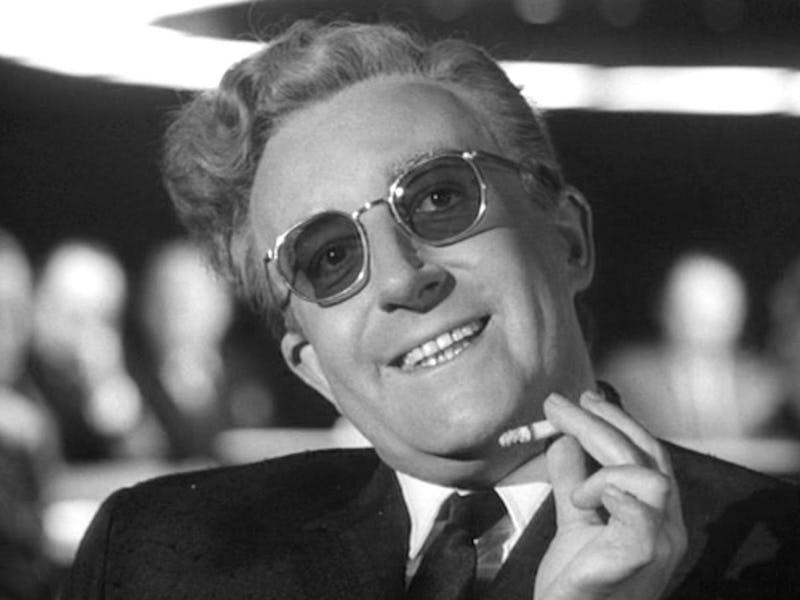Decades After the Cold War, Dr. Strangelove Remains the Best Response to a Climate of Doom
Sometimes you just have to laugh.

From The Last of Us to Leave the World Behind, we are awash in stories about humanity being undone by plague and conflict, most told in such dour tones, you can cheer yourself up afterward with a nice documentary about the Donner Party. Our bottomless appetite for post-apocalyptic media would appear to jive with our own cynical outlook: a growing number of Americans think our species is facing imminent doom.
But despite catering to a society of downers, our current wave of apocalyptic pop culture can’t or won’t credibly imagine how we’d manage our own extermination. We’ll blame the supernatural or some vague political breakdown, then jump ahead to the human drama waiting in the ruins. Even stories about the planet taking revenge on us rely on mutant fungus and evil fog, zombies ultimately being more interesting than half-read articles about climate change.
This lack of imagination was not a problem for Dr. Strangelove, which came out two years after the Cuban Missile Crisis helpfully refreshed everyone’s memories on the possibility of nuclear annihilation. The Cold War had already produced movies that imagined a fiery apocalypse in vivid detail (if you thought The Last of Us was too cheery, try On the Beach), but Stanley Kubrick took a different tone. If we exterminate ourselves, a series of cartoonish blunders will precede the requisite sad montage.
Dr. Strangelove kicks off at a United States Air Force base, where General Jack D. Ripper (Sterling Hayden) informs Captain Lionel Mandrake (Peter Sellers) that the Soviet Union has begun a shooting war. Ripper orders their bomber wing to respond by dropping hydrogen bombs on the USSR, and the base is locked down to foil saboteurs. Then Mandrake realizes an insane Ripper invented the crisis.
Mandrake attempts to tease the abort code out of Ripper, who’d rather talk about the nefarious communist plot to control our minds with fluoridated water. In the Pentagon’s war room, President Muffley (also Sellers), a gaggle of generals, and ex-Nazi scientist Dr. Strangelove (Sellers again) work with the Soviet ambassador to resolve the crisis. And over Russian skies, we see a B-52 crew (featuring Slim Pickens and a young James Earl Jones) dutifully follow their orders to go end countless lives.
Kubrick had set out to make a thriller inspired by Cold War nuclear policy, only for the subject matter’s dark absurdities to drive him toward comedy. Dr. Strangelove is a black satire — Sellers’ lengthy, semi-improvised attempt to explain to the drunk Soviet premier that Ripper “went and did a silly thing” is a masterpiece of comedic acting — but it’s also a sort of anti-thriller. All the power has been given to the last people who should have it, and every sincere attempt to investigate and solve the problem leads us to stupider places.
The War Room is a grand, stately backdrop for some of the dumbest conversations you’ll ever hear.
It’s a stretch to also call Dr. Strangelove a sci-fi movie, but it is a movie where technology designed to be foolproof promptly foils its creators at every conceivable turn. Ripper uses the bombers’ anti-sabotage tech to sabotage America. When Mandrake finally puzzles out the abort code, he’s reduced to desperately scraping up change for a payphone so he can share it. Then the Soviets reveal their computerized doomsday machine, which automatically and unerringly responds to any nuclear attack by wiping out all life on Earth. When it’s pointed out that such a deterrent only works if you warn the rest of the world about it, the Soviet ambassador sheepishly admits they’d planned a surprise reveal on Monday. No technology is above misuse by the arrogant.
Dr. Strangelove took its plot from Peter George’s deadly serious Red Alert, while another novel, Fail-Safe, so closely resembled George’s book that Kubrick sued to have its film adaption delayed. Fail Safe wound up a fine movie about how the terrifyingly cold logic of nuclear war trapped us in a bureaucratic hell of our own making, but Dr. Strangelove is the more memorable film. Sometimes a crisis is so terrifying the only safe response is to laugh.
We aren’t totally bereft of post-apocalyptic comedy today — Zombieland and The World’s End spring to mind — but those revel in genre, not reality. Don’t Look Up comes closest, but its smug jokes are always on someone else: the people too stupid to watch and nod along. In Dr. Strangelove, as gag after gag is delivered with a straight face, it becomes clear the joke is on everyone.
So you might as well go out with a smile.
Unlike many a modern satire, Dr. Strangelove also knew when to play things horrifyingly straight. Most of the B-52s are eventually recalled by Mandrake’s heroics, leaving the fate of humanity in the hands of a single bomber crew who can’t be contacted. In any other story, the sole survivors would be our heroes, competently doing their jobs despite incredible odds against them. Here, they heroically do the wrong job, dutifully ticking off every box on a logical checklist that leads to annihilation. It’s a potent reminder of how much professionalism exists to produce corpses.
At first blush, Dr. Strangelove — a mad science blend of Wernher von Braun, Edward Teller, and nuclear strategist Herman Kahn — is an odd title character, given his limited role. But in his last scene, mere moments after a computerized weapon dooms the world, he suggests using a computer to decide who gets to enter America’s bomb shelters… after ensuring he’ll be chosen regardless. Nuclear war may no longer be our chief concern, but the logic that the people in charge will always be immune from the unintended consequences of their own decisions is eternal. That makes Dr. Strangelove easy to still laugh at, no matter what you’re worried about today.